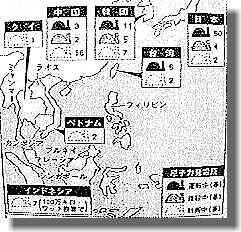연혁
- 1992년 한국반핵운동진영의 제안으로 반핵아시아 포럼 결성!
1992년 반핵운동의 한일연대, 아시아연대의 성과를 계승하고 92년 6월에 열린 브라질 리우환경회의를 대비한 Pre-Brazil회의가 5월 1일 일본의 요코하마에서 열렸다. 이 회의에서 한국의 반핵운동가 김원식 선생이 <반핵아시아포럼>의 구성을 제안한 것이 시작이었다. 이후 "핵 없는 세상을 위하여"라는 기치에 따라 핵에 반대하는 아시아 지역 반핵운동의 네트워크로 각 회원국가들을 돌아다니며, 1년에 한번씩 모임을 가지는 것을 원칙으로 하고 있다. 10회 대회 이후부터는 현안이 있는 지역을 중심으로 프로그램이 진행되고 있다. 한국, 일본, 태국, 필리핀, 인도네시아, 말레이시아, 대만, 인도, 태국, 호주 등 아시아 각 국의 반핵운동가들로 모여진 반핵아시아포럼은 일상적으로는 반핵에 대한 정보 공유와 활동공유를 해왔다.
1993년 6월 26일부터 7월 4일까지 일본에서 최초로 반핵아시아포럼이 열렸다.
아시아지역 핵산업 확대의 심각성 / 플루토늄 수송강행 등을 통한 일본 정부의 핵무장 계획 반대를 주요구호로 내걸며 <[핵무기]도 [핵발전소]도 필요없다! 아시아포럼>이 개최되었다.
한국측 11명, 대만측 15명, 인도, 인도네시아, 태국, 필리핀, 말레이시아 참가자 각국별로 1∼2인, 그리고 주최국인 일본의 각 지역을 대표하는 반핵활동가 150여 명 등 총 200명 정도가 중심이 되었다. 일본 현지의 많은 지역주민이 참가했으며, 국제 회의 외에 핵발전소 현지 등 28군데에서 집회, 정보교환과 경혐교류를 진행하기도 했다..
1994년 10월 한국에서 개최했다. 1990년 11월 안면도 핵폐기장 후보지 선정반대 투쟁이 승리한 이후에도 정부는 울진, 영일(청하), 양산, 고성, 장흥 등에 후보지 선정을 강행하려 하고 있었다. 그리고 당시 9기의 핵발전소가 가동중이었고, 영광핵발전소 3호기의 핵연료 장전이 허가되는 등 핵발전정책이 지속적으로 추진되고 있었지만, 이를 반대하는 반핵투쟁이 종교계와 학생층에까지 서서히 확산 되고 있었다.
제2회 반핵아시아포럼을 열며 핵폐기장 반대운동이 펼쳐진 울진에서 현지주민과 교류, 핵발전소 증설 반대운동이 활발한 영광에서 집회를 진행했다.
대만은 40년간 계속된 계엄령이 해제되고 87년 경부터 민중운동이 활발히 일어나게 되었지만 대만 정부는 계엄령 하에서 이미 핵발전소를 6기나 세워버렸다. 그러나 7기째부터는 주민들의 건설반대 투쟁이 활발히 전개되었다. 대만의 경우 야당이 국회에서 반핵발전소를 내걸면서 커다란 정치적 이슈를 만들고 반핵과 민주화 등과 관련된 운동으로 펼치기도 했다.
대만 정부는 야미족이라는 소수민족 3천명 정도가 살고 있는 작은 섬 "란유섬"에 통조림공장을 짓는다며 거짓말하고, 핵폐기물드럼통을 10만개나 반입시킨 일도 있었고, 이에 대항하여 야미족 사람들의 힘찬 투쟁이 계속되기도 했다.
이 같은 대만에서 열린 제 3회 반핵아시아포럼에서 열린 반핵집회는, 대만 제 4핵발전소 반대투쟁과 프랑스 핵실험반대투쟁이 함께 진행되어 타히티에서 온 참가자도 포함한 2만명에 이르는 대규모 집회로 확장되기도 했다. 그리고 번화가 한가운데서 핵무기와 핵발전소 모형에 불붙여 태우는 大아트랙션도 벌였으며, 이러한 것을 통해 대만반핵운동으로부터 많은 교훈을 배울 수 있었다.
1996년 7월 28일부터 8월 2일까지 6일간에 걸쳐 제4회 반핵아시아포럼이 인도네시아에서 개최되었다. 당시 수하르트 군사 독재 정권 하인 인도네시아에서 열렸기 때문에 미리 반핵아시아포럼 명칭을 사용하지 못했고, 데모나 옥외 활동이 어려웠던 점, 현지주민과 교류하는데도 미묘한 문제가 있는 점 등 역대 포럼 중에서 가장 힘들게 행사가 진행되기도 했다. (이처럼 행동이 자유롭지 못한 나라에 핵발전소를 짓는 것이 얼마나 반민주적이고 위험한 것인지를 알 수 있다.)
긴박한 상황 아래 개최하였지만, 자바섬 이외에도 많은 사람들이 참가하여, 인도네시아 최초의 핵발전소 개획에 반대하는 전국 네트워크를 탄생시키는 계기가 되었다. 이후 자카르타 등 지방에서도 착실하게 핵발전소에 대한 의식이 생겨나 반대운동이 일어났고, 인도네시아 민주화 움직임과 함께 발전하기도 했다.
아시아를 비롯 유럽 미국에서도 참가자가 합세해 5회 NNAF가 필리핀에서 개최되었다. 본격적으로 아시아에 핵발전소 수출이 시작되는 전야라고도 할 수 있는 1997년이라는 해에 진행되었다. 건설이 완료되었으나 민중의 힘으로 폐쇄를 몰아붙인 바탐핵발전소 현지에서 2천명이 횃불데모를 하여 참가자들의 가슴을 뜨겁게 했다고 한다.
1998년 10월 26일부터 11월 1일까지 태국에서 개최되었다. 아시아 회원국 외에도 캐나다, 네덜란드에서 참가했으며, WISE, Greenpeace 등의 NGO들도 높은 관심을 보이고 참가했다. 태국에는 핵발전소가 없지만, 당시 일본 핵산업의 진출로 연구용 원자로가 계획되고 있었고, 남부에서는 이미 캐나다형 경수로 건설이 예정되어 토지 매수도 시작하고 있었다. "지속가능한 대체에너지 프로젝트(AEPS)"라는 단체가 주축이 되어 준비했고, 핵발전소 예정지에서 최초의 주민 집회를 가지기도 했다.
11월 22일부터 26일까지 인도에서 열렸다. 인도는 아시아에서 최초로 핵발전소를 개발한 나라이다. 만성적인 전력부족 해소를 구실로 정부의 대대적인 비호 아래 강대한 힘을 가진 원자력위원회가 있었으며, 주민의 의사와는 상관없이 핵발전소 추진정책이 계속되어 왔다. 당시 인도에서는 10기의 핵발전소가 상업가동중에 있었다. 인도에서 조업중인 우라늄광산으로는 자두고다 광산이 유일한데 새로운 우라늄 광산개발계획이 여기저기에 추진되고 있기도 했다.
사용후 핵연료 재처리 시설은 트룬베이, 타라푸르, 카르팥카무 3군데이며, 고준위 폐액의 유리고화시설도 여기 3군데에 설치 또는 공사 되는 등 핵연료 사이클의 모든 기술을 보유하고 있다 할 수 있다. 원자로에서 생산된 플루토늄으로 74년과 98년에는 핵실험이 진행되기도 했다. 그런데 인도 핵시설에서는 심각한 사고가 빈발하고 있다. 91년에는 봄베이 근교 바바원자력연구센터 주변에서 파이프파손에 따른 대규모 방사능누출사고가 일어나기도 했다.
7회 NNAF은 우라늄 채굴의 오염피해 보고를 비롯한 가이가 핵발전소와 환경파괴와 싸우는 여러 사람들과의 만남도 있었다.
작년 7월에 "새로운 에너지의 시대, 21세기를 향하여"라는 주제로 일본에서 열렸다. 도쿄, 1999년 JCO 사고가 일어났던 도카이무라, 주민 투표로 핵발전소를 막아낸 사례가 있는 마키 등을 돌아다니며, 심포지엄과 집회에 참가했다. 한국반핵운동연대 소속 단체들이 함께 참가했다.
아시아 최대의 원자력 추진국이라 할 수 있는 일본에서 열린 NNAF에서는 21세기를 향해 아래와 같은 공동선언하기도 했다.
1. 우리는 인도적 가치관 회복을 촉구하며 아시아에서 핵발전소를 폐지할 것을 요구한다.
2. 우리는 일본정부와 핵발전산업에 대만 제4핵발전소 수출계획을 즉시 중지하도록 요구한다.
3. 우리는 에너지 낭비를 유도하는 현대 경제구조의 개혁을 요구한다.
4. 우리는 세계 많은 주민들의 토지와 권리를 빼앗아 온 우라늄 광산 폐쇄를 요구한다.
5. 우리는 핵무기 보유국의 핵폐기를 요구한다.
6. 우리는 한반도의 민주·평화·통일을 강하게 요구한다.
7. 우리는 사용후핵연료 재처리와 수송에 반대한다.
8. 우리는 안전하고도 책임있는 핵폐기물의 장기관리를 촉구한다.
9월 10일부터 16일까지 한국에서 열렸다. 서울이외에도 부산, 울산 지역을 순회하면서 교류행사를 진행하였다.
9월 28일부터 10월 2일까지 대만에서 열렸다.









